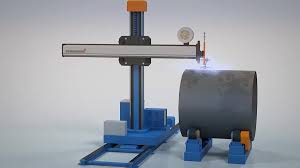Guide to Welding Manipulators
No Comments - Leave a Comment
TYPES OF WELDING MANIPULATORS
Welding manipulator technology is helping companies with welding facilities increase productivity and profitability by reducing downtime and increasing welding speed. Welding manipulators refer to any machine, whether automated or manually operated, that assists in the welding process. Three of the most common types of welding manipulators are rotary welding positioners, rollers and column and boom welders. Each has their own specialty and purpose when welding, and they can often be used in tandem with one another.
Rotary Welding Positioners
Rotary welding positioners have the job of holding a part or weldment from one end and rotating it to give welders or welding machines access to whatever area needs to be welded. They come in all shapes and sizes, with the simplest types of positioners having just one axis of movement or rotation, while some have as many as four or five. They are often paired with a tailstock that supports the other end of the part they are welding, especially for longer or heavier parts. These positioners, especially the ones with three or more axes, can theoretically position even the most complicated and strangely shaped parts so that a welder will have an easier time accessing areas that need welding.
To learn more about Weld Positioners, including Rotary Welding Positioners, go to our guide here!
Roller
Rollers accomplish a similar task to that of rotary welding positioners, however, instead of supporting a weldment or part from either end, the weldment sits on the rollers and is maneuvered or “rolled” so that a welder has access to whatever surfaces need welding. Due to this design, the parts need to be cylindrical so that they are capable of being rolled, meaning that rollers are usually limited to working on parts like pipes and cylindrical storage tanks. Many of the pipes that rollers support have very large diameters, meaning that it would be difficult for a rotary welding positioner’s headstock or tailstock to hold its end, making rollers a perfect alternative when rotary welding positioners can’t support a certain part.

Example – Welding Rollers
Column and Boom
Column and boom manipulators fill a different need than rollers and rotary welding positioners in automated facilities, holding the welding torch instead of the weldment. They often weld parts that are supported either by rotary positioners or by rollers, and primarily have two degrees of freedom, moving vertically and in one direction horizontally, with some also able to rotate about their base. They often can also control the angle of the torch and the distance from the welding surface. They can vary in size from a few feet tall and wide to several stories tall depending on the application. Generally, when working with a rotary welding positioner, smaller column and boom units are required, while when working with rollers, it is usually on very large diameter pipes and tanks, calling for a very large column and boom unit.
Example – Column and Boom Welding Manipulator
When trying to decrease downtime and increase productivity, purchasing the right welding manipulators for a company’s operation can dramatically improve production levels. Rollers and rotary welding positioners make it easier for human welders or automated welders, such as column and boom units, to access welding positions and weld more quickly. Automated welders including column and boom units can also weld more quickly than a human and do not fatigue or need time off as humans do. Automation with welding manipulators will improve quality and consistency, and maximize productivity.
To learn more about Welding Positioners, visit our guide here.
Comments
No Comments - Leave a Comment

 Translate
Translate